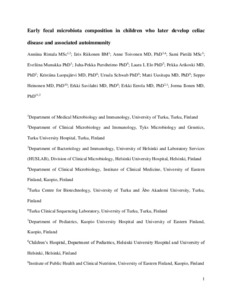Early fecal microbiota composition in children who later develop celiac disease and associated autoimmunity
Anniina Rintala; Iiris Riikonen; Anne Toivonen; Sami Pietilä; Eveliina Munukka; Juha-Pekka Pursiheimo; Laura L. Elo; Pekka Arikoski; Kristiina Luopajärvi; Ursula Schwab; Matti Uusitupa; Seppo Heinonen; Erkki Savilahti; Erkki Eerola; Jorma Ilonen
https://urn.fi/URN:NBN:fi-fe2021042719027
Tiivistelmä
Objectives: Several studies have reported that the intestinal microbiota composition of celiac disease (CD) patients differs from healthy individuals. The possible role of gut microbiota in the pathogenesis of the disease is, however, not known. Here, we aimed to assess the possible differences in early fecal microbiota composition between children that later developed CD and healthy controls matched for age, sex and HLA risk genotype.
Materials and methods: We used 16S rRNA gene sequencing to examine the fecal microbiota of 27 children with high genetic risk of developing CD. Nine of these children developed the disease by the age of 4 years. Stool samples were collected at the age of 9 and 12 months, before any of the children had developed CD. The fecal microbiota composition of children who later developed the disease was compared with the microbiota of the children who did not have CD or associated autoantibodies at the age of 4 years. Delivery mode, early nutrition, and use of antibiotics were taken into account in the analyses.
Results: No statistically significant differences in the fecal microbiota composition were found between children who later developed CD (n = 9) and the control children without disease or associated autoantibodies (n = 18).
Conclusions: Based on our results, the fecal microbiota composition at the age of 9 and 12 months is not associated with the development of CD. Our results, however, do not exclude the possibility of duodenal microbiota changes or a later microbiota-related trigger for the disease.
Kokoelmat
- Rinnakkaistallenteet [27094]
